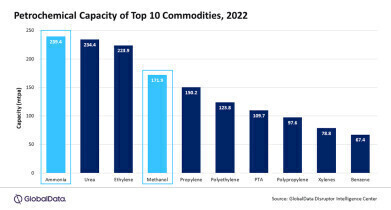Fuel for thought
Ammonia and methanol set to lead decarbonisation in petrochemical sector
Dec 08 2023
Ammonia and methanol are key industrial chemicals with strong demand in agriculture, manufacturing, and construction sectors. Conventional ammonia and methanol production processes contribute to carbon emissions. As governments around the world are pursuing various decarbonisation strategies, it has become imperative to curb emissions from these processes. The evolution of low-carbon hydrogen, a critical feedstock for both ammonia and methanol, can help in decarbonising these chemicals, says GlobalData, a leading data and analytics company.
GlobalData’s thematic report, “Ammonia and Methanol in Energy Transition,” provides an overview of developments in the low-carbon ammonia and methanol markets. It further benchmarks leading companies in low-carbon ammonia and methanol production, such as Yara International, CF Industries, SABIC, OCI, and Nutrien, based on their active and upcoming capacity, emissions intensity, and net zero commitments.
Ravindra Puranik, Oil and Gas Analyst at GlobalData, comments: “Low-carbon hydrogen and carbon capture technologies are gaining prominence in the petrochemical sector. Companies such as Yara and CF Industries are actively harnessing these technologies to decarbonise their respective production processes for chemicals such as ammonia and methanol.”
Green hydrogen produced from electrolysis of water by harnessing renewable energy has an enormous potential in production of green ammonia and green methanol. Whereas blue hydrogen, which is produced by employing carbon capture technologies, offers a long-term alternative in the energy transition of ammonia and methanol production.
Ammonia is a key petrochemical product with the agricultural sector being a massive demand driver. It is the most widely produced petrochemical in the world. Methanol also has significant installed capacity among petrochemical products and has strong demand in the manufacturing sector.
Ammonia and methanol market segments can be more readily decarbonised using low-carbon hydrogen for their production. It would also help mitigate the emissions from end use applications that rely on these two chemicals. In the global energy transition, ammonia is potentially viewed as a fuel in shipping and power generation, while low-carbon methanol can be blended with gasoline and diesel fuels.
Puranik continues: “Shipping industry, the backbone of global trade, overwhelmingly consumes fossil fuels and thus significantly contributes towards carbon emissions. The shipping regulator, the International Maritime Organisation (IMO), is considering ammonia and methanol among the fuel options for its net-zero goals. Furthermore, using methanol either directly or after blending with petroleum fuels, contributes to a reduction in vehicular emissions.”
Strong growth is expected in the number of blue ammonia and methanol plants in this decade. The number of green ammonia and methanol plants is expected to surge rapidly as 2030 draws closer.
Puranik concludes: “Hydrogen is seen to be synonymous with global objectives for decarbonisation and energy transition, making it a key theme for the oil and gas industry. The prospects of low-carbon ammonia and methanol are directly linked with the success of low-carbon hydrogen. Given the steady trend of low-carbon investments, the year 2030 could be a landmark year for the ammonia and methanol markets.”
Digital Edition
PIN 26.1 Feb/Mar 2025
March 2025
Analytical Instrumentation - Elemental Analysis for Quality and Process Control at Refineries, for Lubricants and Wear Metals in Engine Oils - Synthetic Lubricants: New Developments - Scaling...
View all digital editions
Events
Apr 29 2025 Mumbai, India
Apr 29 2025 Edmonton, AB, Canada
May 05 2025 Houston, Tx, USA
May 06 2025 Nuremberg, Germany
Canada Gas & LNG Exhibition & Conference
May 06 2025 Vancouver, BC, Canada



















